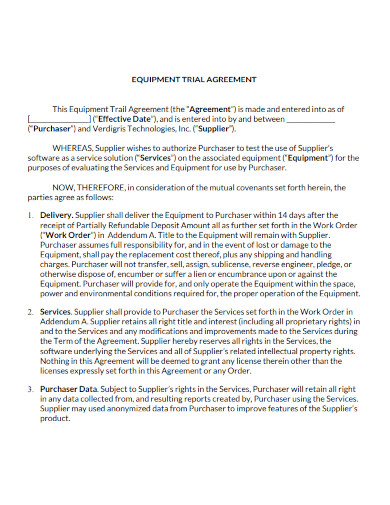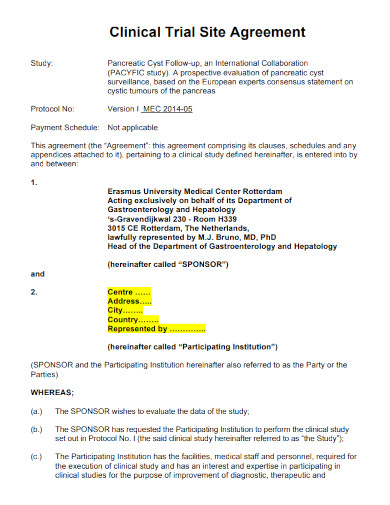A Shop Rental Agreement is a legally binding document that outlines the terms and conditions for renting a commercial shop space. It defines the roles, responsibilities, and obligations of…
continue reading
9+ SAMPLE Printable Trail Agreement
-

Sample Trial Agreement Template
download now -

Free Product Trial Agreement Template
download now -

Clinical Trial Agreement Template
download now -

Equipment Trial Agreement Template
download now -

Software Trial Agreement Template
download now -

Equipment Trial Agreement
download now -

Software Trial License Agreement
download now -

Clinical Trial Site Agreement
download now -

Trail Construction and Maintenance Agreement
download now -

Sample Trail Participant Agreement
download now
What is a Trial Agreement?
Introduction:
A Trial Agreement is a legal sample document designed to outline the terms, conditions, and objectives of a trial period or test phase between parties entering into a collaborative endeavor. This comprehensive agreement serves as a business roadmap, ensuring clarity, cooperation, and fair evaluation during the trial. Let’s delve into the types, key points, and essential components of a Trial Agreement.
Types of Trial Agreements:
1. Product Trial Agreement:
Used when testing a new product’s functionality, usability, and market appeal.
2. Service Trial Agreement:
Applied when evaluating the effectiveness and quality of a specific service.
3. Research or Scientific Trial Agreement:
Designed for scientific experiments, studies, or clinical trials, outlining research methodologies and participant rights.
4. Partnership Trial Agreement:
Establishes the terms for a trial period in a business partnership or joint venture.
Key Points in a Trial Agreement:
1. Trial Duration:
Clearly specifies the duration of the trial period, including start and end dates.
2. Objectives and Scope:
Defines the specific goals, scope, and expected outcomes of the trial.
3. Responsibilities of Each Party:
Outlines the roles, responsibilities, and contributions expected from each participating party.
4. Confidentiality:
Includes clauses to protect confidential information exchanged during the trial.
5. Data Ownership:
Determines ownership and usage rights of data generated or collected during the trial.
6. Financial Arrangements:
Addresses any financial considerations, such as costs, payment terms, or compensation during the trial.
7. Termination Conditions:
Specifies conditions under which either party can terminate the trial agreement.
8. Compliance with Regulations:
Ensures that the trial adheres to relevant legal and ethical regulations.
Components of a Trial Agreement:
1. Title and Introduction:
Clearly identifies the document and provides a brief overview of the collaboration.
2. Recitals:
States the background and purpose of the trial, setting the context for the agreement.
3. Definitions:
Clarifies terms used throughout the agreement to avoid misunderstandings.
4. Trial Plan:
Details the plan and methodologies for conducting the trial, including any specific protocols.
5. Terms and Conditions:
Encompasses all agreed-upon terms and conditions governing the trial period.
6. Dispute Resolution Mechanism:
Establishes a structured process for resolving disputes between the parties.
7. Governing Law and Jurisdiction:
Specifies the legal agreement of framework governing the agreement and the jurisdiction in case of legal matters.
8. Signatures:
Concludes the agreement with the signatures of all involved parties, indicating their commitment.
Who Signs a Clinical Trial Agreement?
In the context of clinical trials, a clinical trial agreement is typically signed by the sponsor and the institution where the trial is conducted. The sponsor is usually the individual, company, or organization that initiates and financially supports the clinical trial. The institution, often a research or healthcare facility, is where the clinical trial activities take place.
The principal investigator, who is responsible for overseeing the trial at the institution, may also be involved in the agreement. Additionally, institutional review boards (IRBs) or ethics committees may review and approve the clinical trial agreement to ensure that the research agreement follows ethical guidelines and protects the rights and well-being of the participants.
It’s important to note that the specific parties involved and their roles may vary depending on the nature of the clinical trial and the agreements negotiated among the parties involved.
What Happens if the Trial is Successful?
If a trial is successful, it typically leads to the next phase of the agreement or collaboration. The specific outcomes and subsequent steps can vary depending on the nature of the trial and the goals set in the Trial Agreement. Here are some common scenarios:
1. Negotiation of Long-Term Agreement:
If the trial is successful, the parties involved often enter into negotiations to establish a more permanent and comprehensive agreement. This could be a long-term contract, partnership agreement, or another form of collaboration.
2. Expansion of the Trial:
In some cases, a successful trial may lead to an expansion of the initial trial period. This could involve scaling up the scope of the trial or extending its duration to gather more data or test the product or service under different conditions.
3. Implementation of the Product or Service:
For trials involving products or services, success may result in the full-scale implementation of the product or service. This could involve launching it to a broader audience or incorporating it into regular business operations.
4. Further Research or Development:
In scientific or research trials, success may prompt further research or development. This could involve additional studies, refinement of the tested product, or exploration of related areas.
5. Establishment of a Long-Term Partnership:
A successful trial may lead to the establishment of a long-term partnership between the parties involved. This partnership could extend beyond the initial trial objectives, encompassing ongoing collaboration and mutual benefit.
6. Celebration of Milestones:
Successful trials are often celebrated as milestones. This recognition may include acknowledgment of achievements, joint announcements, or other forms of recognition depending on the nature of the collaboration.
You May Also See Work Trial Agreement
How are Disputes Resolved in a Trial Agreement?
Dispute resolution mechanisms are crucial components of any contractual agreement, including Trial Agreements. Including clear and effective dispute resolution provisions helps parties address conflicts in a fair and structured manner. Here are common approaches to resolving disputes in a Trial Agreement.
1. Negotiation:
Parties may attempt to resolve disputes amicably through negotiation. This involves open communication and discussion between the involved parties with the goal of reaching a mutually acceptable resolution agreeemnt.
2. Mediation:
Mediation involves the appointment of a neutral third party, the mediator, who assists the parties in reaching a resolution. The mediator does not make decisions but facilitates communication and helps the parties find common ground.
3. Arbitration:
Arbitration is a more formal process where a neutral third party, the arbitrator, reviews the evidence presented by both parties and makes a binding decision. This decision is often enforceable in a court of law.
4. Escalation Clauses:
Some Trial Agreements include escalation clauses that outline a step-by-step process for resolving disputes. This could involve progressing from negotiation to mediation and, if necessary, to arbitration or another formal resolution method.
5. Governing Law and Jurisdiction:
Specifying the governing law and jurisdiction in the Trial Agreement helps determine which legal system applies in case of a dispute. This can simplify the resolution process and provide clarity on the applicable legal framework.
6. Dispute Resolution Timelines:
Including specific timelines for each step of the dispute resolution process helps ensure that conflicts are addressed promptly. This can prevent unnecessary delays in resolving issues.
7. Expert Evaluation:
In certain cases, the Trial Agreement may include provisions for expert evaluation. This involves obtaining an opinion from a qualified expert in the field related to the dispute to assist in reaching a resolution.
8. Termination Clause:
In extreme cases where disputes cannot be resolved, the Trial Agreement may include a termination clause that allows one or both parties to terminate the agreement. This is typically a last resort after other resolution attempts have failed.
How to write Trail Agreement ?
Writing a Trail Agreement involves careful consideration of the specific context and goals of the trial. Below is a step-by-step
guide to help you draft a comprehensive Trail Agreement:
1. Title and Introduction:
Provide a clear and descriptive title for the agreement.
Introduce the document with a brief overview of the collaboration and the purpose of the trial.
2. Parties Involved:
Clearly identify and introduce the parties entering into the agreement.
Include the legal names, addresses, and any other pertinent details.
3. Recitals:
Outline the background and context of the trial, including the objectives and smart goals.
Set the stage for the specific terms and conditions outlined in the agreement.
4. Definitions:
Define key terms and concepts used throughout the agreement to avoid ambiguity.
5. Objectives and Scope:
Clearly state the goals and scope of the trial.
Define what success looks like and the criteria for a successful trial.
6. Responsibilities of Each Party:
Outline the roles, responsibilities, and contributions expected from each participating party.
Clearly specify who is responsible for what aspects of the trial.
7. Trial Plan:
Detail the plan for conducting the trial, including methodologies, procedures, and any specific protocols.
Specify the timeline and milestones if applicable.
8. Confidentiality:
Include clauses to protect confidential information exchanged during the trial.
Clearly define what constitutes confidential information and the obligations of each party regarding confidentiality.
9. Data Ownership:
Determine ownership and usage rights of data generated or collected during the trial.
Address how data will be handled, stored, and shared.
10. Financial Arrangements:
Address any financial considerations, such as costs, payment terms, or compensation during the trial.
Specify how expenses will be handled and reimbursed.
11. Termination Conditions:
Clearly specify the conditions under which either party can terminate the trial agreement.
Include any notice periods or specific triggers for termination.
12. Compliance with Regulations:
Ensure that the trial adheres to relevant legal and ethical regulations.
Include clauses regarding compliance with local and international laws.
13. Dispute Resolution Mechanism:
Establish a structured process for resolving disputes between the parties.
Specify whether negotiation, mediation, arbitration, or a combination will be used.
14. Governing Law and Jurisdiction:
Specify the governing law that will apply to the agreement.
Define the jurisdiction for legal matters, if applicable.
15. Signatures:
Conclude the agreement with the signatures of all involved parties.
Ensure that each party has reviewed and understands the terms before signing.
16. Review and Legal Advice:
Review the draft thoroughly to ensure clarity, consistency, and completeness.
Seek legal advice to ensure that the agreement complies with relevant laws and regulations.
Who are the parties involved in a Trial Agreement?
The parties involved typically include the sponsor (initiator and financial supporter), the institution or facility conducting the trial, and possibly the principal investigator overseeing the trial.
What does a Trial Agreement Usually Cover?
A Trial Agreement covers details such as the trial duration, responsibilities of each party, confidentiality, data ownership, financial agreement arrangements, and any specific conditions for the trial period.
In conclusion, crafting an effective Trial Agreement necessitates meticulous attention to detail and clarity. Follow our guide and tips to ensure a comprehensive document that outlines objectives, responsibilities, and key terms. By incorporating precise language, addressing confidentiality, and establishing dispute resolution mechanisms, your Trial Agreement becomes a robust tool for successful collaborations, fostering transparency and cooperation.

